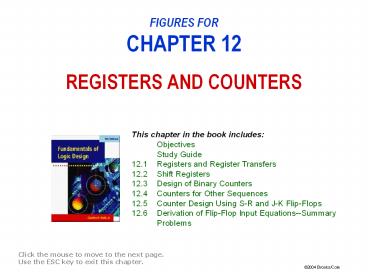FIGURES FOR CHAPTER 12 REGISTERS AND COUNTERS - PowerPoint PPT Presentation
1 / 43
Title:
FIGURES FOR CHAPTER 12 REGISTERS AND COUNTERS
Description:
FIGURES FOR CHAPTER 12 REGISTERS AND COUNTERS This chapter in the book includes: Objectives Study Guide 12.1 Registers and Register Transfers 12.2 Shift Registers – PowerPoint PPT presentation
Number of Views:246
Avg rating:3.0/5.0
Title: FIGURES FOR CHAPTER 12 REGISTERS AND COUNTERS
1
FIGURES FORCHAPTER 12REGISTERS AND COUNTERS
This chapter in the book includes Objectives St
udy Guide 12.1 Registers and Register
Transfers 12.2 Shift Registers 12.3 Design of
Binary Counters 12.4 Counters for Other
Sequences 12.5 Counter Design Using S-R and J-K
Flip-Flops 12.6 Derivation of Flip-Flop Input
Equations--Summary Problems
Click the mouse to move to the next page. Use the
ESC key to exit this chapter.
2
Figure 12-1 4-Bit D Flip-Flop Registerswith
Data, Load, Clear, and Clock Inputs
3
Figure 12-2 Data Transfer Between Registers
4
Figure 12-3 Logic Diagram for 8-Bit Register
with Tri-State Output
5
Figure 12-4 Data Transfer Using a Tri-State Bus
6
Figure 12-5 N-Bit Parallel Adder with
Accumulator
7
Figure 12-6 Adder Cell with Multiplexer
8
Figure 12-7 Right-Shift Register
9
Figure 12-8 8-Bit Serial-In, Serial-OutShift
Register
10
Figure 12-9 Typical Timing Diagram forShift
Register of Figure 12-8
11
Figure 12-10Parallel-In,Parallel-OutRight
Shift Register
12
Table 12-1 Shift Register Operation
13
Figure 12-11 Timing Diagram for Shift Register
14
Figure 12-12 Shift Register withInverted
Feedback
15
Figure 12-13 Synchronous Binary Counter
16
Table 12-2 State Table for Binary Counter
17
Figure 12-14 Karnaugh Maps for Binary Counter
18
Figure 12-15 Binary Counter with D Flip-Flops
19
Figure 12-16 Karnaugh Maps for D Flip-Flops
20
Figure 12-17 State Graph and Tablefor Up-Down
Counter
21
Figure 12-18 Binary Up-Down Counter
22
Figure 12-19ab Loadable Counter with Count
Enable
(b)
23
Figure 12-20 Circuit for Figure 12-19
24
Figure 12-21 State Graph for Counter
Table 12-3 State Table for Figure 12-21
25
Figure 12-22
26
Table 12-4. Input for T Flip-Flop
27
Figure 12-23 Counter Using T Flip-Flops
28
Figure 12-24 Timing Diagram for Figure 12-23
29
Figure 12-25 State Graph for Counter
30
Figure 12-26 Counter of Figure 12-21 Using D
Flip-Flops
31
Table 12-5. S-R Flip-Flop Inputs
32
Table 12-6.
33
Figure 12-27Counter of Figure 12-21 Using S-R
Flip-Flops
34
Figure 12-27Counter of Figure 12-21Using S-R
Flip-Flops
(c) Logic circuit
35
Table 12-7. J-K Flip-Flop Inputs
36
Table 12-8.
37
Figure 12-28Counter of Figure 12-21 Using J-K
Flip-Flops
38
Figure 12-28Counter of Figure 12-21Using J-K
Flip-Flops
39
Table 12-9. Determination of Flip-Flop Input
Equations from Next-State Equations Using
Karnaugh Maps
40
Example Illustrating the Use of Table 12-9
41
Figure 12-29aDerivation of Flip-Flop Input
EquationsUsing 4-Variable Maps
42
Figure 12-29bDerivation of Flip-Flop Input
Equations Using 4-Variable Maps
43
Figure 12-29cDerivation of Flip-Flop Input
Equations Using 4-Variable Maps































